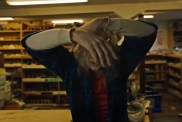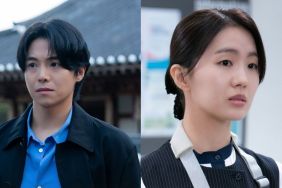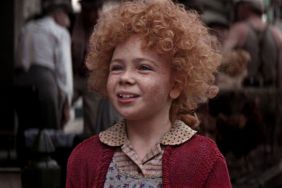“I just assumed I was gonna be Australian, and I was all hopped up and excited to do an Australian accent. I did “Love Actually” and they didn’t let me do a British accent, so I thought I’d get to do an Australian accent! But no.”
This mild exasperation was uttered by actress Laura Linney (The Squid and the Whale, The Truman Show) as she discussed her starring role in the new indie feature Jindabyne, which despite taking place in, being filmed in, and made by natives of Australia did not require the striking, assured actress a crack at a formidable accent. If seeing Ms. Linney attempt her best Paul Hogan imitation was something you would have enjoyed, you have only director Ray Lawrence (Lantana) to blame.
“It was important for Ray to show Australia as a melting pot, as a place that’s not just purely white Australian inhabitants. That was very important to him. I think it does give another level of discomfort to the movie, my husband’s Irish, I’m American, how’d they get there? It forces you to ask questions, this movie. It forces you to follow through on stuff.”
The Irish husband, Stewart, is played by none other than Gabriel Byrne (The Usual Suspects), who sets the story of Jindabyne in motion when he and his buddies discover the naked body of a young Aboriginal girl floating in the water during their annual fishing trip. They heartlessly decide to tether the body to a rock and continue to fish for the weekend before reporting the discovery, and when they return to their hometown, they face harsh judgments from the townspeople, the Aborigine community and their loved ones.
“I suppose the central story point, for want of a better description, is when the men find the body,” said Byrne. “From the men’s perspective what they do is they have a very brief discussion about what the best thing to do is from a logical and practical point of view. ONLY from a logical and practical point of view they decide that by the time they get back to report this incident the girl will either be washed over the cliffs for some other indignity or if they take her out of the water her body will be desecrated. They’ve come a very great distance to fish, so they take what they believe is the logical, practical decision, but as the audience watches there’s a very subtle change in the relationship between the audience and the men.
“The audience becomes the moral judges of the action. It turns from a practical and logical solution into a moral problem. That brings up questions for an audience. ‘What would I do in that situation? Would I have behaved differently? If it had been three women who found the body would they have reacted differently. If it had been a young boy would they have reacted differently?’ A really interesting question.”
Upon her husband Stewart’s return and subsequent criticism, Linney’s character Claire takes it upon herself to carry the burden of accountability for his actions, attempting to play the peacekeeper among the families of the four fishermen whose lives are thrown into disarray. She also makes a seemingly futile attempt to extend an olive branch of understanding to the family of the murdered girl. According to Linney, these actions are linked to a period of post-partum depression her character suffered from years before the events of the film but mentioned throughout.
“I think specifically she does it because she feels that she was wronged at one point, and that nobody helped her. When someone reaches that kind of precipice, either emotionally or physically, it changes the way you treat people, completely. I think she’s not capable of letting this go, it is not okay, there is nothing okay about this, and she will not participate. The psychology of it is not a simple one, but a lot of it deals with her actions in the past and how she’s been treated. You do all that [character background] work on it and then you let it go, and then it bleeds through.”
Byrne continued, “When they return to the town where they live they are already involved in a moral dilemma which they could never have imagined. The film opens up into an examination of how women react to trauma and crisis and how men do. The men become silent and withdrawn and distant and defensive, and the women confront the issue in a very direct way. One of the themes of the film is how do men and women differ in relation to how they deal with complex emotional issues.”

Both Byrne and Linney have built their careers on taking chances with small, intimate dramas like this one, and it is not surprising that the risky nature of the scripts is the very thing that is attractive to actors of their caliber. This central event of the story, the discovery of the body by fishermen, is taken from a short story “So Much Water, So Close to Home” by late-author Raymond Carver. The story was previously woven into the tapestry of Robert Altman’s Carver adaptation Short Cuts, where it was handled with far more detachment and levity. The “Jindabyne” script expands on the story by very seriously examining the full ramifications of the fishermen’s actions, on themselves and the community at large.
“If the script is sound and good,” she says, “it will take you to a place you can’t predetermine, nor should you. If you read something and you know what you’re gonna do, that’s bad. That’s not a good sign. If you see something you think you can do in your sleep you should not do it, you’ll get lazy, it’ll be thin, and it won’t be very good. This character is so emotionally like phyllo dough, there’s layer upon layer upon layer upon layer. She’s saturated, she’s like a full sponge. She’s just filled with so much stuff, and I had no idea if any of it would come through.
Byrne took similar emotional risks with his character of Stewart by embracing the inherent weakness of such an unscrupulous yet utterly average man.
“I do not know how I would react if I came across the dead body of a raped girl in a river. I decided I would make it as un-heroic as I possibly could, that’s why the guy is terrified to touch the body, doesn’t want to turn it over, becomes hysterical, starts to shout, blesses himself. The reason he blesses himself in moments of great crisis you go back to moments in childhood that say to you ‘this’ll protect you, this’ll make you safe.’ We filmed that and left it like that. It then led on to a discussion of what the nature of heroism is, because we’re constantly being told in conventional mainstream films that heroes react in a particular way, heroines react in a particular way, the sidekick reacts in a particular way. So we know the language of cinema backwards, we know what’s gonna happen if Harrsion Ford kicks down the door. We kinda know he’s not gonna say ‘Oh, no no no no don’t hurt me! Oh no, I didn’t really mean to have this gun, no please.'”
Having played a married couple onscreen twice before, in 1994’s A Simple Twist of Fate and 2004’s P.S., Linney and Byrne were able to create both convincing tension and a believable history together.
“We figured out a definite skeletal structure of the marriage, and then both went our separate ways. This is also my third troubled marriage with Gabriel. We do troubled marriages really well! You’re at a huge advantage when there’s someone who you’ve worked with before in a capacity like that and it really allows you to go a little deeper. You can just sort of run with it, like a really good dance partner.”
According to Byrne, “There are many forms of heroism. The marriage of Stewart and Claire in the film. To go on being married to the same person all your life knowing that part of you has had to give up another part of yourself. I’m not talking about the part that says ‘oh, I had to give up playing sports on Saturdays.’ The part of you that has to give up the possibility of romance with another person. The part of you that has to give up PASSION with another person. The part of you that has to say ‘this is who I married for the rest of my life and this is who I stick with.’ To go through that kind of relationship day after day after day after day is heroic, and to inflict a great hurt on a person you love, ask for their forgiveness, and be forgiven, is not as simple as it seems.”
Another element of tension added into the mix is the continued appearance of the Aboriginal girl’s killer, Gregory (Chris Haywood), a white-bearded psychopath who is never caught but crosses paths with Linney’s Claire throughout the film. The sense of dread created by his presence is doubled by the crafty decision of the filmmakers to leave the psychology of this murderous character ambiguous, open to interpretation. Indeed, the film is bookended by images of Gregory sitting in his truck parked ominously behind a rock.

Says Linney, “Every single character in this movie you could write a book on, and [the killer] represents danger around the corner. He kills the way at the end he gets stung by that wasp, the way a wasp will sting people. Indiscriminate. And, you know, I don’t think he likes women. (laughs) Danger exists, you know? Sometimes people are not held accountable, and how does someone’s actions affect someone else? So much of this is about consequence, consequences. Everyone is haunted by something in their past that they have done, and it completely affects the way they treat their family, their friends, their community.”
Says Byrne, clearly still reeling along with the rest of the world in the shadow of the Virginia Tech massacre, “The reason I think the film is unsettling is because it presents a world that we all know, whether we can articulate that on a regular basis or not. We live in a tremendously unpredictable and chaotic world. We do not know when the next awful thing is going to happen. Three days ago, a situation which who could have predicted that? It’s happened before but who could have predicted that guy down the corridor is a guy who kills 33 people because he’s enraged. That’s the guy waiting behind the rock.
“There’s a beautiful moment in the film where the mother tries to comfort the child and she says to him ‘Don’t worry, everything will be alright,’ and at seven-years of age the child turns to the wall and says ‘Crap.’ You realize that whether we like it or not our children have absorbed to their bones our fears and our cynicism. Violence, whether it’s Iraq, or if it’s a guy shooting 33 people, or whether it’s a Korean guy shot in his supermarket, or whether it’s the violence of war, children understand that they live in a violent world.”
For Linney, the chance to make Jindabyne, like her previous indie efforts Kinsey and You Can Count On Me, offered the kind of challenges that she relishes as an actress.
She says, “It was also just a real sort of acting lesson. The entire time we were making the movie I was kind of like ‘how little can I do?’ How much can I trust myself to do very little and trust that all the work I’ve done will come through? It was fun that way, particularly when you have a director who only does one take. As opposed to being very hyper-alert and on, you have to do the opposite, you have to be very relaxed. You have to be very very relaxed, cause when you get uptight and tense everything narrows. The more relaxed you get the more opportunity there is, you receive things differently, you’re more able to respond. It was all about letting go. You have to just let the sands go right through your fingers.
“I’m doing this enormous miniseries right now for HBO, ‘John Adams’, and I’ve forgotten what it’s like to work for a company that has money. It’s enormous and BEAUTIFUL, and I’ve never seen anything like it and it’s a shock to be working with a company that has an enormous amount of money and spending it. I’m used to the really low low low low budget ones where you’re forced to be creative. On independent movies people are not as afraid of each other and everyone sort of works together, there’s a much more inter-dependent feel. The bigger movies people are not as the stereotype is its much more of an ensemble feel, even with the crew, on an independent movie ’cause you’re just screwed if you don’t help each other out. Money is something that you really have to respect, particularly when it enters into the world of the arts. It can be EXTREMELY helpful, or it can be absolute poison.”
Jindabyne opens in New York and L.A. today, April 27.









